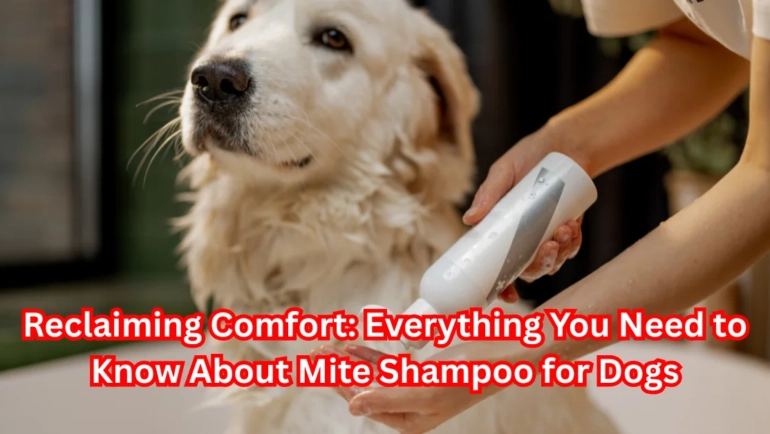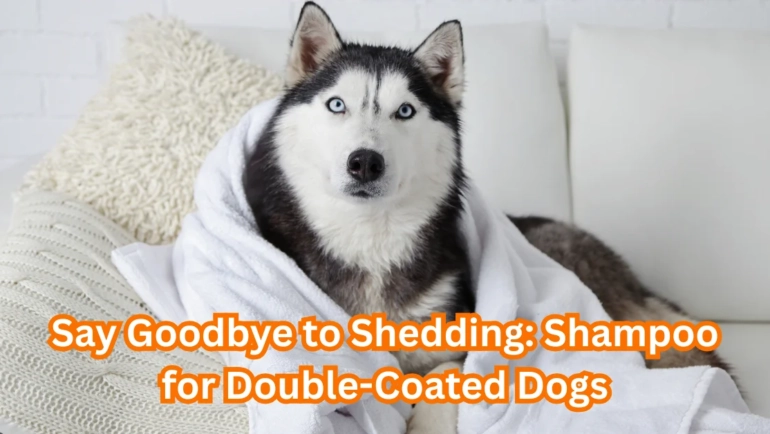
How to Dilute Dog Shampoo: Simple 5 Steps for Beginners
Did you know that giving your dog shampoo straight from the bottle can hurt its skin? I didn’t realize it until my dog got a bath and started acting irritated. We all want our dogs to be clean and comfortable as dog owners. But sometimes, even when we mean well, we might make their bath time unpleasant by accident. The good news? It’s easy: water down the shampoo. The shampoo will last longer, baths will be kinder, and you might even save money.
I’m now going to show you how to mix dog shampoo properly, why it’s important, and how to get the most out of each bottle. As long as it’s safe and doesn’t cause your pet any stress, we’ll groom them.
How Do You Make Liquid Dog Shampoo at Home?
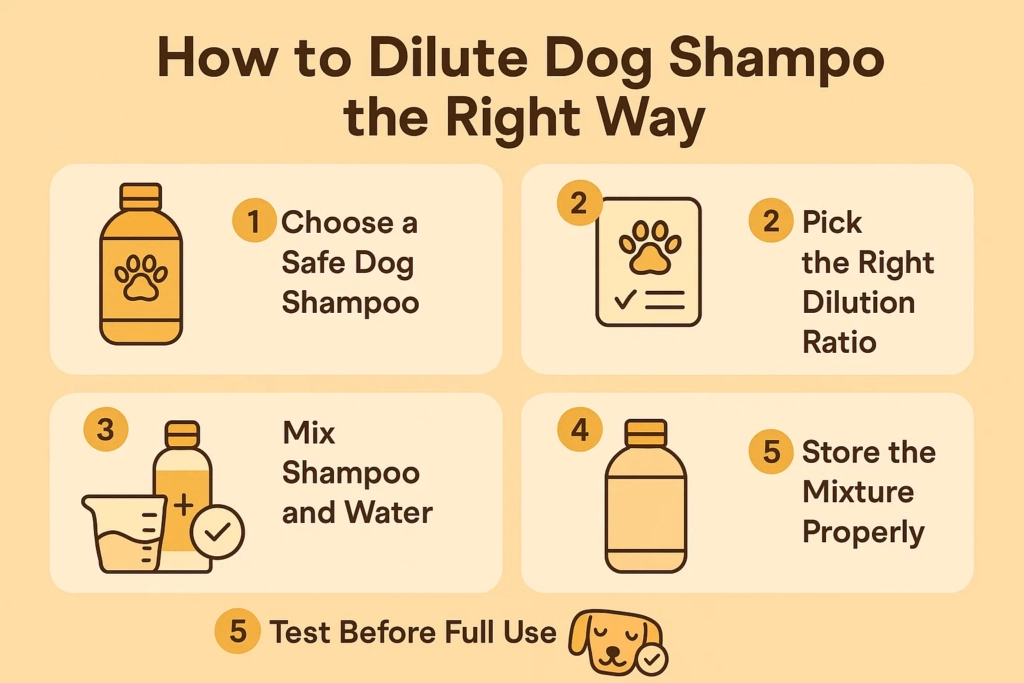
To make liquid dog shampoo at home, all you need are two ingredients: your dog shampoo and clean water. Mixing them softens the shampoo, making it easier to spread and more cost-effective.
Here’s a step-by-step guide to do it safely and correctly:
1. Choose a Safe Dog Shampoo
Start with a good-quality dog shampoo made specifically for dogs. Avoid shampoos that contain harsh chemicals, artificial colors, or strong fragrances. Never use human shampoo, baby shampoo, or dish soap, as these can irritate your dog’s skin.
You can use either:
- Concentrated base of Shampoo (online or Pet stores)
- A liquid dog shampoo that you already have at home
2. Choose the Correct Dilution Agency
The right dilution ratio depends on your dog’s skin type, coat thickness, and the shampoo you’re using.
Common dilution ratios are:
- For very dirty or heavily coated dogs: use 1 part shampoo to 2 parts water
- For daily use: mix 1 part shampoo with 3 parts water
- For dogs with sensitive skin or those bathed often: dilute 1 part shampoo to 4 parts water or more
If you’re unsure where to start, mix 1 part shampoo with 3 parts water. You can adjust the ratio later based on how your dog’s skin reacts.
3. Mix the Shampoo and Water
Pick up a clean bottle, bowl, or jug. Add the shampoo and water in the amount you want. Give it a good stir or shake until it’s smooth and free of lumps. When you wash, clumps can make it uneven.
Tip: Use warm water, not hot, to help dissolve the shampoo and keep your dog comfortable.
4. Store the Mixture Properly
Pour the diluted shampoo into a clean squeeze or pump bottle. Seal it tightly to prevent leaks or spills. Label the bottle with the dilution ratio and date so you remember what’s inside.
Keep the bottle in a cool, dry place away from direct sunlight. Use the mixture within 1 to 2 weeks for best freshness and safety.
5. Test Before Using
Do a patch test on your dog before you bathe him all over. Mix shampoo with water, then put a small amount behind your dog’s ear or on its belly. You should wait 24 hours and look for any signs of discomfort, such as redness, dryness, or itching.
If the skin looks healthy, you’re good to go for a full bath.
Bonus Tip: Use a Mixing Bottle
You can find pet mixing bottles with measurement marks to make diluting shampoo easier and less messy, especially helpful if you bathe your dog regularly.
It’s that simple! Diluted dog shampoo saves money and is gentler on your furry friend.
Why Dilute Dog Shampoo?
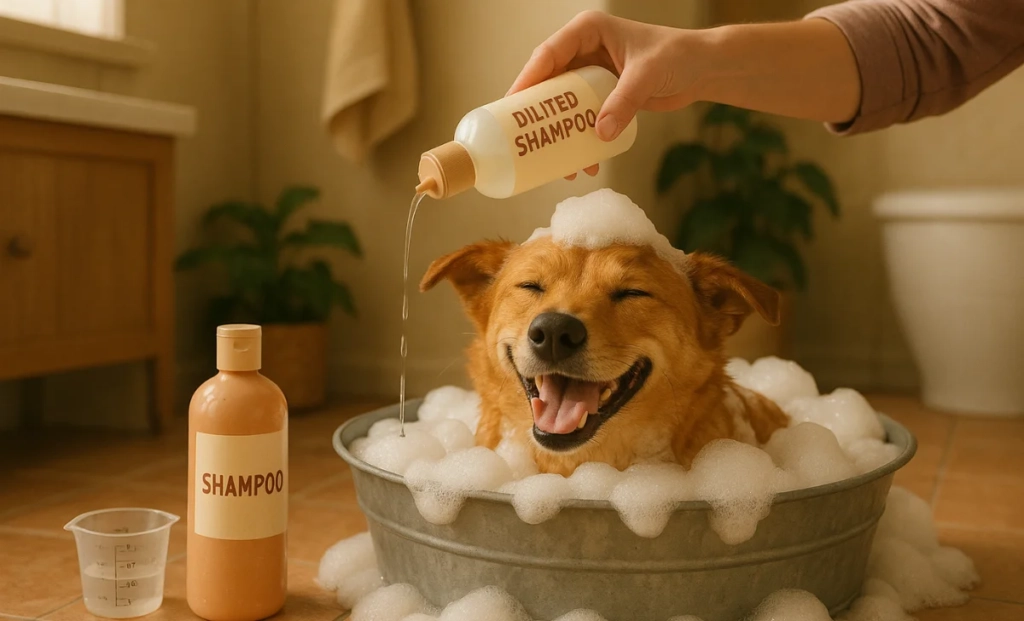
Dilution of dog shampoo helps in softening it, making it cheaper and makes it easier to apply. It is an intelligent selection with regard to your dog’s skin and your pocket.
These are the primary advantages of the dilution of dog shampoo:
1. Nice to Sensitive Skin
Strong shampoo needs to be avoided sometimes since it may be too strong on certain dogs with allergies, dry skin, and sensitive skin. By diluting the shampoo, you reduce the concentration of its active ingredients, making it much milder on your dog’s skin and coat.
Diluted shampoo aids:
- Hoist dryness/pruritus
- Avoid rashes or allergies
- Preserve the natural oils of the skin
This is critical, particularly for young puppies, older dogs, and breeds with sensitive skin.
2. Is Money Saving in the Long Run
Shampoo should be diluted so that each bottle used lasts longer. Instead of a large mat of product used in a single bath, it is possible to spread it out over multiple washings by diluting it in water.
This is best when:
- You take your dog out to wash frequently
- You keep several dogs
- You apply high-grade or medicated shampoos
Even a diluted mixture will achieve the same goal, but use less and save you in the long run.
3. Lessen Strong Perfumes
Many dog shampoos have strong scents that can overwhelm your dog’s sensitive nose. Diluting the shampoo softens the smell while still keeping your dog clean and fresh.
This helps make bath time less stressful, especially for dogs that dislike strong fragrances.
4. Easier to Clean and Rinse
It penetrates your dog’s fur more quickly with diluted shampoo, especially if it has a thick or double coat. It also rinses off faster, so you spend less time in the tub, and there is less chance that shampoo will stay on your skin. Less residue means skin that itches less and stays healthier.
It’s a simple step that makes a big difference to water down your dog’s shampoo. It keeps your dog’s skin from getting dry, saves you money, and makes bath time easier for both of you.
What Is the Best Ratio for How to Dilute Dog Shampoo?
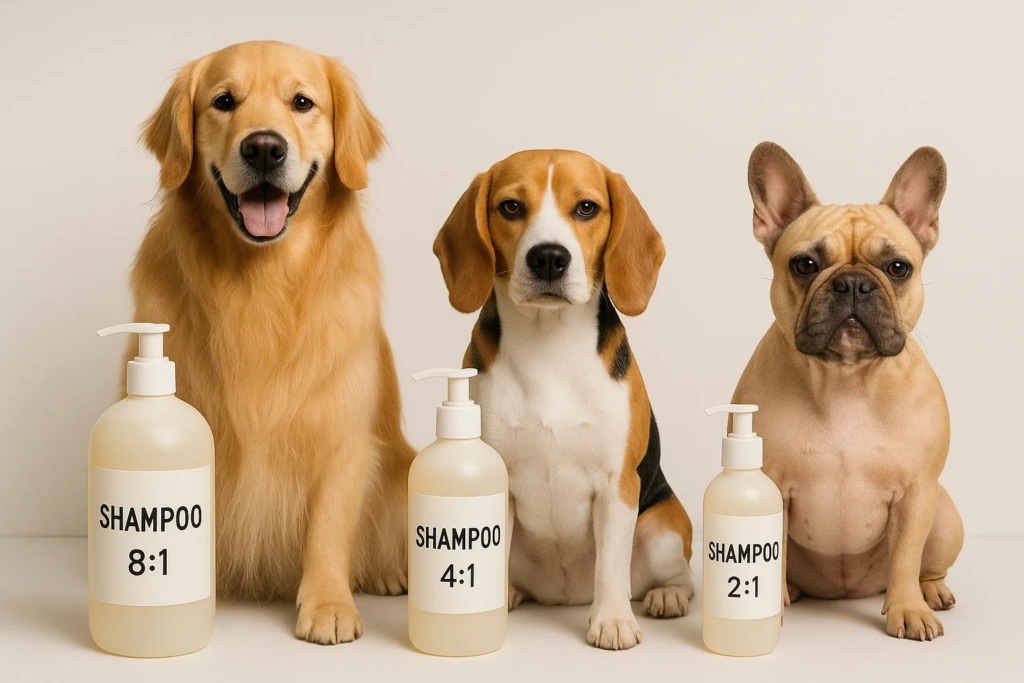
The ideal dilution ratio for dog shampoo is usually 1 part shampoo to 3 parts water. This 1:3 mix is gentle, effective, and works well for most dogs with normal skin and coats.
However, every dog is different. The best ratio may vary depending on your dog’s skin condition, coat type, and fur thickness. Using the right dilution helps prevent skin irritation, makes rinsing easier, and makes bath time more comfortable for your dog.
Recommended Dog Shampoo Dilution Ratios
| Dog Type | Recommended Ratio (Shampoo: Water) | Why This Ratio Works |
| Sensitive skin or allergies | 1:4 | Extra gentle. Reduces the chance of irritation or dryness on delicate skin. |
| Thick or long coats | 1:2 | A slightly stronger mix helps the shampoo reach the skin through dense fur. |
| Normal or short coats | 1:3 | Balanced dilution. Cleans well while being gentle enough for regular use. |
| Puppies or senior dogs | 1:4 or 1:5 | Very mild mix. Safe for more delicate or ageing skin that needs extra care. |
| Medicated or concentrated shampoo | Follow the label or 1:5 to 1:10 | Always read instructions. These formulas are strong and often require heavy dilution. |
By adjusting the amount of shampoo and water based on your dog’s needs, you can protect their skin, keep their coat healthy, and make grooming more enjoyable.
How Long Is Diluted Dog Shampoo Good For?
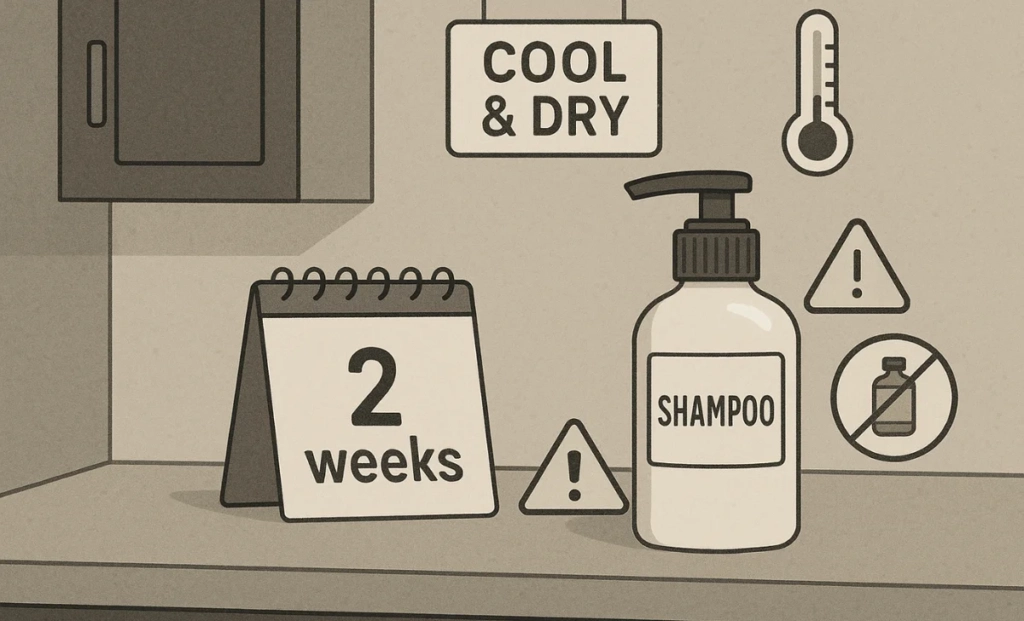
When diluted properly, dog shampoo stays safe and effective for about one to two weeks. Although some mixtures can last up to a month, it’s best to use new batches frequently to prevent irritation or contamination. When you mix shampoo with water, germs can grow, especially in warm, damp places. The shampoo will stay fresh longer if you store it in a clean bottle that doesn’t let air in. Keep it somewhere cool and dry, out of the sun and heat.
Never use containers that aren’t properly cleaned, as this can cause the shampoo to spoil quickly. Before each use, check the shampoo’s smell, texture, and color. Throw it away and make a new batch if it smells bad, looks cloudy, or has split.
Can You Add Water to Shampoo Without Compromising Quality?
Yes, you can add water to dog shampoo without losing any of its quality as long as you use the right amount. You can reduce the amount of dog shampoo, especially the very concentrated ones. This makes them easier to put on and more comfortable for your dog while they’re bathing. Wet shampoo works great as long as it is mixed well and used right away. But the shampoo won’t work right if you water it down too much. However, if you don’t use enough water, the shampoo could be too strong and hurt or dry out your dog’s skin. The ratio that works best for your dog’s skin and hair depends on the shampoo, but most shampoos work well when diluted at 1:3 to 1:4.
To keep your dog and the shampoo safe, only mix what you need and use the shampoo right away after diluting it.
Final Thoughts
Diluting your dog shampoo not only helps it last longer and saves you money, but it’s also a smart and caring choice that puts your dog’s comfort and health first. Some dogs have sensitive skin, or may just need a gentler clean, and finding the right mix makes all the difference.
Bath time doesn’t have to be stressful. With a little extra care and attention, it can become a calming routine that strengthens the bond between you and your pup. Don’t be afraid to try different ratios and find what works best.
Your dog deserves the best care, and now you know to give it.
Smart Bathing Questions About How to Dilute Dog Shampoo
1. Can I use human shampoo on my dog in an emergency?
It’s best to avoid it. Human shampoos can disrupt your dog’s skin pH, leading to dryness or irritation. Use plain water or a dog-safe alternative like oatmeal paste if you’re in a pinch.
2. How often should I bathe my dog with diluted shampoo?
Most dogs do well with a bath every 4 to 6 weeks. If your dog gets dirty often or has skin conditions, you may need to adjust the schedule based on your vet’s advice.
3. Does dilution affect the shampoo’s flea-killing ability?
Yes. Medicated or flea-control shampoos should be diluted only if the label allows it. Over-dilution may reduce effectiveness. Always follow product instructions closely.
4. Can I pre-mix a large batch of diluted dog shampoo?
You can, but it’s best used within 1 to 2 weeks. Store it in an airtight bottle in a cool, dry place. Make smaller batches to ensure freshness and reduce bacterial growth.
5. What kind of water should I use to dilute dog shampoo?
Room-temperature tap water is fine for most dogs. If your dog has sensitive skin, filtered or distilled water can help avoid irritation from hard water minerals.
6. Can I use a conditioner after diluted shampoo?
Yes. After rinsing out the shampoo, you can use a dog-safe conditioner to add moisture and shine. Make sure to rinse it thoroughly to avoid residue buildup.
7. Why does my dog itch after a bath, even with diluted shampoo?
Itching can result from leftover shampoo, sensitivity to ingredients, or overbathing. Try rinsing more thoroughly and switching to a hypoallergenic or fragrance-free formula.
8. Is it okay to add essential oils to diluted shampoo?
Not recommended unless approved by a vet. Some essential oils are toxic to dogs. Stick to shampoos with dog-safe ingredients already included in the formula.
9. Can I use diluted shampoo on puppies?
Yes, but only use shampoos labelled safe for puppies. Dilute it more than usual (like 1:4 or 1:5) to make it extra gentle for their delicate skin.
10. How do I know if I’ve rinsed the shampoo out completely?
Run your hand through your dog’s coat. If it feels slippery or sudsy, keep rinsing. Use lukewarm water and be patient; residue can cause itching and skin problems.


